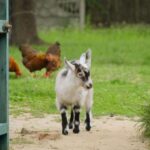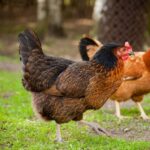Wyandotte chickens are amongst the most popular breeds of backyard chickens. The silver laced is one of the most iconic and stunning looking chickens.
Whether you’re wondering if this breed is right for you, or you just want some more information about their history - these facts about Wyandotte chickens should tell you everything you need to know:
Table of Contents
13 Facts About Wyandotte Chickens
- Wyandottes are a “true” American breed and was developed in the early 1870s in New York State.
- Their name comes from the Native American tribe called Wyandotte nation, although they don’t seem to be associated with the tribe.
- The original color is the Silver Laced Wyandotte. In addition to this color, there are eight more colors in total recognized by the American Poultry Association; black, buff, blue, golden laced, Columbian, partridge, silver penciled, and the buff Columbian (bantam only).
- They have a docile and friendly temperament - one of the reasons why they’re a popular choice for backyard chicken owners.
- Wyandottes typically lay around 200 eggs a year. That’s about 4 eggs a week.
- They lay throughout the winter better than a lot of other breeds, making them more suitable for colder climates.
- They lay medium-large brown eggs.
- The hens typically weigh around 7 lbs, and the roosters are around 9 lbs. Making them a medium to large-sized bird.
- They are known for their sweet and docile personalities, they are fine being handled, and make great pets.
- The average lifespan of a Wyandotte is 6-12 years.
- Wyandottes have a rose comb, with medium-sized red wattles.
- They are classified as a dual-purpose breed, meaning they are raised for both meat and eggs.
- They are one of the quietest breeds, making them a good choice for urban settings (and for anyone with close neighbors).
Are Wyandotte Chickens a Good Backyard Breed?
Wyandotte chickens are perfect for homesteads and backyard settings.
They’re social birds that enjoy some fussing, will play nice with other breeds, and great with children. So, they’ll fit in with a busy or a quiet household.
If you’re keeping them for their eggs - as most people do - 200 or so eggs a year per hen is plenty.
Just think, with 3-4 hens that means you’ll be collecting 600-800 large eggs a year. That should be more than enough to keep your friends, family, and neighbors happy.
Another huge plus about this breed is that they adapt well to both being confined, and roaming free-range.
Of course, the more space you can allow them the better.
But they’ll do just fine in a coop and run enclosure, and if let free they’ll forage and scratch around for food and are surprisingly self-sufficient.
In a nutshell; they are not prone to any health issues, are easy to look after, good layers, and will provide you with a load of entertainment - what more could you want?
Related questions:
How Big Do Wyandotte Chickens Get?
They are on the larger side weighing in at around 7 lbs for the hens, and up to 9 lbs for the roosters.
They don’t look it though, as their plumage is not really dense with close-knit feathers. If they’re too big but you’ve fallen in love with them, why not look into getting a bantam. They’re a third to a half the size physically but have all the pros of being a Wyandotte.
Are Silver Laced Wyandottes Good Layers?
Silver laced Wyandottes lay the same number of eggs as any color of Wyandottes. You can expect 4 or so eggs a week or 200 eggs a year.
This puts them in the “good layers” category. They’re not as prolific as California Whites or Rhode Island Reds. They do however lay better than those breeds through the winter, which is a bonus.
Are Wyandotte Chickens Loud?
They are not amongst the loudest breeds, that’s for sure. They do walk around clucking and will sing the “egg song”, they’re chickens after all.
However, if you’re in the market for a quiet breed because you live in an urban area - or just because you have neighbors - they are one of the quietest breeds.
Interested in more chicken facts? Check out a couple of the most popular posts:
Facts about Rhode Island Red chickens
Image credits - Header photo by Dimitri Houtteman on Unsplash




